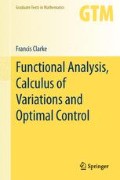Abstract
A Banach space X is called a Hilbert space if it admits a bilinear mapping (x,y) ↦ 〈 x ,y 〉 X that generates its norm, in the following sense:
The bilinear mapping is then referred to as an inner product on X. Canonical cases of Hilbert spaces include \({\mathbb{R}}^{ n} \), L 2(Ω), and ℓ 2. Some rather remarkable consequences for the structure of the space X follow from the mere existence of this scalar product. We begin the chapter with a review of the basic theory of Hilbert spaces. Then we present a smooth minimization principle, in which the differentiability of the Hilbert norm plays a crucial role. The final sections introduce the proximal subdifferential, an important tool in nonsmooth (and nonconvex) analysis.
Access this chapter
Tax calculation will be finalised at checkout
Purchases are for personal use only
Notes
- 1.
In dealing with vector spaces defined over the complex number field rather than the reals, inner products are correspondingly complex-valued. In that case, the condition \(\langle \, x\,,y\,\rangle _{X}\: = \:\overline{\langle \, y\,, x\,\rangle _{X}}\) is imposed, where the bar refers to complex conjugate. We continue to limit attention throughout, however, to the real-valued case.
- 2.
This is a special case of a theorem due to Borwein and Preiss, and also of a general result due to Deville, Godefroy, and Zizler; the proof is taken from [20, p.11].
- 3.
We remark that, just as one says “f prime” or “dee f” for the derivative of f, the conclusion of Prop. 7.26 is often voiced as follows: dee P f equals dee f (or “curly dee f ”); a saving of considerably many syllables.
References
R. Deville, G. Godefroy, and V. Zizler. Smoothness and Renormings in Banach Spaces. Pitman Monographs 64. Longman, UK, 1993.
H. L. Royden. Real Analysis. Macmillan, London, 1968.
Author information
Authors and Affiliations
Rights and permissions
Copyright information
© 2013 Springer-Verlag London
About this chapter
Cite this chapter
Clarke, F. (2013). Hilbert spaces. In: Functional Analysis, Calculus of Variations and Optimal Control. Graduate Texts in Mathematics, vol 264. Springer, London. https://doi.org/10.1007/978-1-4471-4820-3_7
Download citation
DOI: https://doi.org/10.1007/978-1-4471-4820-3_7
Published:
Publisher Name: Springer, London
Print ISBN: 978-1-4471-4819-7
Online ISBN: 978-1-4471-4820-3
eBook Packages: Mathematics and StatisticsMathematics and Statistics (R0)

